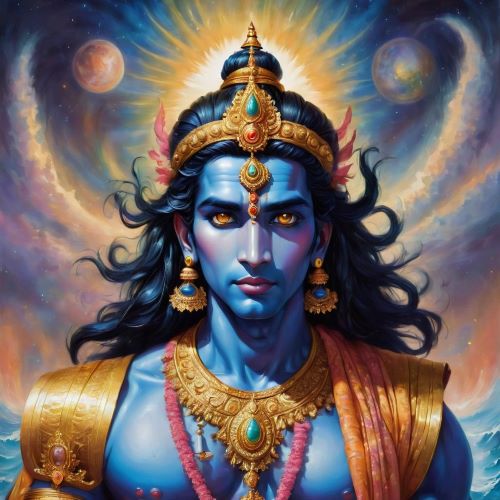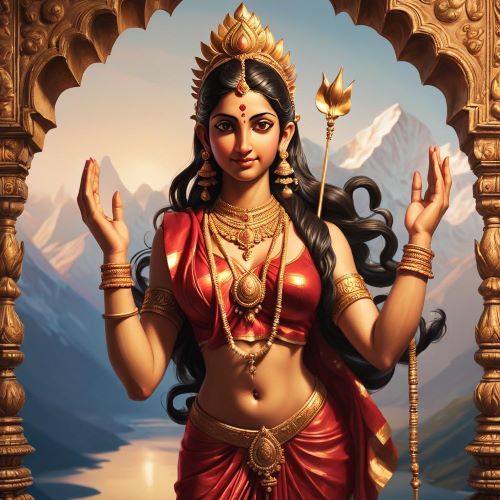Bhumi : The Earth Mother
Listen
At a glance
| Description | |
|---|---|
| Origin | Indian Gods |
| Classification | Gods |
| Family Members | Narakasura, Mangala, and Sita (Children) |
| Region | India |
| Associated With | Earth |
Bhumi
Introduction
In Indian mythology, Bhumi, also known as Prithvi, is the personification of the Earth and a revered goddess in several ancient texts. She embodies the essence of stability, fertility, and support, symbolizing the nurturing aspects of the Earth. As a deity, Bhumi represents the crucial connection between the divine and the physical realm, fulfilling roles as both a cosmic entity who sustains the Earth and a motherly figure who nourishes all living beings.
Bhumi, also honored as Bhumi Devi or Prithvi Devi, reflects the core essence of our planet in Hindu mythology. She is more than a mere physical landmass; she is a nurturing presence who supports all life. Revered as Bhudevi and Vasundhara, Bhumi is a significant Hindu goddess and the consort of Varaha, an avatar of Vishnu. In Vaishnava tradition, she stands alongside Sridevi and Niladevi as one of Vishnu’s consorts, playing an essential role in the mythological and natural world.
Physical Traits
Bhumi’s physical representation varies widely, with no single, definitive portrayal. Often depicted as a graceful woman, she might be adorned with jewels and green or golden garments that symbolize her bond with nature. Some images show her holding a lotus flower, representing purity and fertility, or a pot overflowing with grains to signify abundance. Alternatively, she may be portrayed emerging from the earth, her strong arms nurturing vegetation or animals, underscoring her role as the sustainer and protector of life.
In certain depictions, Bhumi is associated with elephants, symbols of strength, wisdom, and stability, which highlight her enduring and nurturing qualities. Her serene demeanor is often illustrated through a calm and gentle appearance, with artistic elements reflecting fertility and agriculture, such as grains or flowers. Sometimes, she appears as a robust figure with a lush green hue, symbolizing the Earth’s fertility and richness.
Visual representations of Bhumi frequently include natural elements like mountains, rivers, and plants, emphasizing her deep connection to the Earth. In some images, she is shown seated on a platform supported by four elephants, representing the cardinal directions. She is typically depicted with four arms, holding various items: a pomegranate, a water vessel, a bowl of healing herbs, and another bowl of vegetables. Occasionally, she is shown with two hands, holding a blue lotus (Kumuda or Utpala) and displaying mudras such as the Abhayamudra (fearlessness) or Lolahasta Mudra (resembling a horse’s tail).
Family
Bhumi holds a prominent place in Hindu mythology, deeply intertwined with the cosmic order through her familial connections. She is notably the consort of Vishnu in his Varaha (boar) incarnation. In this myth, Vishnu assumed the form of a boar to rescue Bhumi, who had been submerged by the demon Hiranyaksha in the cosmic ocean. This act highlights Bhumi’s significance as the Earth goddess and Vishnu’s protective nature.
Additionally, Bhumi is regarded as the daughter of the sage Manu, a key figure in Hindu tradition associated with the origin of humanity. This lineage reinforces her role as a nurturing force vital to life’s creation and sustenance. Bhumi is also connected to various offspring, including Narakasura, Mangala, and Sita. In the Dvapara Yuga, she incarnated as Satyabhama, a consort of Krishna, to aid in the defeat of the demon Narakasura. Andal, a female Alvar, is also considered an avatar of Bhumi.
Her relationship with Vishnu in his Varaha form signifies the restoration of cosmic balance. Vishnu’s rescue of Bhumi from Hiranyaksha, where he lifted her with his tusks, symbolizes the divine connection between the Earth and the preserver of the universe. Bhumi’s offspring further illustrate her diverse roles. While Narakasura, a powerful demon, reflects the potential for destructive forces that arise from the Earth, her connection to Sita, an epitome of purity, highlights the spectrum of possibilities stemming from her nurturing nature. These varying accounts underscore the complexity of Bhumi’s role rather than diminishing it.
Furthermore, Bhumi is one of Vishnu’s consorts alongside Sridevi, the goddess of fortune. While Sridevi represents material wealth, Bhumi embodies the foundational wealth of the Earth, together portraying a comprehensive vision of prosperity that includes both material and terrestrial abundance.
Other names
Bhumi’s significance in Hindu mythology is reflected through her many names, each highlighting different facets of her character. She is commonly known as Bhudevi, which means “earth goddess,” and Vasundhara, meaning “the bearer of wealth,” emphasizing her connection to fertility and abundance. Other names such as Vasumati, “the bountiful one,” and Prithvi Mata, “Earth Mother,” underline her nurturing and life-giving nature. Titles like Dharti and Dharani, derived from the Sanskrit “dhrti” meaning “to sustain,” further stress her role as the support of life.
In addition to these, Bhumi is also referred to by names like Bhuvani and Bhuvaneshwari, which translate to “sovereign of the world,” reflecting her divine authority over the Earth. Other names such as Varahi, indicating strength and protection, and various regional or cultural epithets like Vaishnavi, Kashyapi, Urvi, and Ira, illustrate her diverse roles and attributes. Each of these names contributes to the rich tapestry of her character in Hindu mythology, portraying her as an essential and multifaceted deity.
Powers and Abilities
As the personification of the Earth, Bhumi wields considerable power, crucial for sustaining life. She is the ultimate source of fertility, ensuring the ongoing renewal of life through her nurturing abilities. Her divine influence extends to healing and restoring balance, with acts like touching the Earth symbolizing a connection to her restorative energy. Bhumi’s role in providing fertile soil, water, and resources is fundamental to agriculture and environmental health, making her essential for the growth and sustenance of all life forms.
However, Bhumi’s power also encompasses the enforcement of natural balance. Natural disasters such as earthquakes and floods can be seen as manifestations of her discontent with humanity’s actions, serving as reminders of the delicate equilibrium of nature and the repercussions of neglecting the Earth. Bhumi’s abilities include maintaining stability, supporting ecosystems, and protecting the planet from harm, as highlighted in mythological stories like Vishnu’s rescue of her from Hiranyaksha. These facets of her power underscore her role in ensuring both the prosperity and preservation of life on Earth.
Modern Day Influence
Bhumi’s impact reaches into contemporary issues, particularly environmental challenges. As a symbol of the Earth’s nurturing and sustaining qualities, she inspires modern environmental movements focused on conservation and sustainability. Her legacy is evident in initiatives such as Earth Day, where her role as the Earth goddess underscores the importance of protecting our planet. Worship practices, including rituals and festivals dedicated to Bhumi Devi, express gratitude and reinforce the commitment to environmental stewardship.
In cultural contexts, Bhumi continues to be honored through festivals like Pongal and Makar Sankranti, which celebrate agricultural abundance and reflect her role in providing sustenance. Her image also appears in art, from traditional paintings and sculptures to modern environmental campaigns. These representations serve as a reminder of our deep connection with the Earth and the need for harmonious living with nature, demonstrating how Bhumi’s influence endures in shaping both cultural and environmental consciousness.
Related Images
Frequently Asked Questions
What is lorem Ipsum?
I am text block. Click edit button to change this text. Lorem ipsum dolor sit amet, consectetur adipiscing elit. Ut elit tellus, luctus nec ullamcorper mattis, pulvinar dapibus leo.
What is lorem Ipsum?
I am text block. Click edit button to change this text. Lorem ipsum dolor sit amet, consectetur adipiscing elit. Ut elit tellus, luctus nec ullamcorper mattis, pulvinar dapibus leo.
What is lorem Ipsum?
I am text block. Click edit button to change this text. Lorem ipsum dolor sit amet, consectetur adipiscing elit. Ut elit tellus, luctus nec ullamcorper mattis, pulvinar dapibus leo.
What is lorem Ipsum?
I am text block. Click edit button to change this text. Lorem ipsum dolor sit amet, consectetur adipiscing elit. Ut elit tellus, luctus nec ullamcorper mattis, pulvinar dapibus leo.
What is lorem Ipsum?
I am text block. Click edit button to change this text. Lorem ipsum dolor sit amet, consectetur adipiscing elit. Ut elit tellus, luctus nec ullamcorper mattis, pulvinar dapibus leo.












